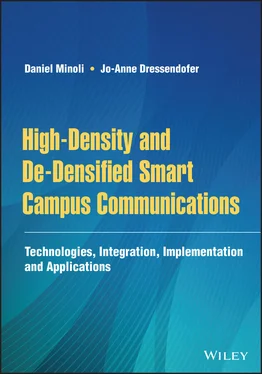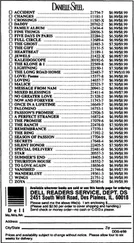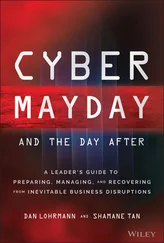1 ...7 8 9 11 12 13 ...23 In addition to content traffic, there is an increasing need to provide IoT‐based functionality such as bathroom sensors for smoking or vaping of substances, Heating, Ventilation, and Air Conditioning (HVAC) operations, and video surveillance.
1.2.6 Pre‐pandemic/Long‐term Requirements for Train and Subway Stations
While some quote a figure of 6 persons per km 2in subway stations [2], it is our pragmatic observation that the densities at rush hour are more in line with the parameters of Table 1.2, with concentration of 1 per 10 ft 2or 1 per 20 ft 2. Table 1.9provides some information on the subway and rapid transit systems in the United States (about 15 systems in total).
1.2.7 Pre‐pandemic/Long‐term Requirements for Dense Office Environments
Office space represents a major environment where work is accomplished in the United States and around the world. Data from the Commercial Buildings Energy Consumption Survey indicates that there were 5.6 million commercial buildings in the United States in 2012 (the most recent year for which data are available), spanning 87.4 billion ft 2of floorspace (see Figure 1.3) [13, 14]. The typical space allocation per employee is 130–150 ft 2, although some lower‐end industries (e.g. retail) allocate less and some higher‐end industries (e.g. law firms) allocate more.
TABLE 1.9 Top Subway and Rapid Transit Systems in the United States
| System |
Annual Ridership (2018) (M) |
Avg. Weekday Ridership (K) |
Stations (Approx.) |
| 1. |
New York City Subway |
2629 |
8765 |
470 |
| 2. |
Washington Metro |
226 |
764 |
90 |
| 3. |
Chicago “L” |
226 |
720 |
145 |
| 4. |
MBTA, Boston |
156 |
510 |
50 |
| 5. |
BART, Bay Area Rapid Transit |
126 |
417 |
46 |
| 6. |
SEPTA Philadelphia |
94 |
328 |
75 |
| 7. |
PATH NJ/NY |
92 |
310 |
13 |
| 8. |
MARTA, Atlanta |
65 |
206 |
38 |

FIGURE 1.3 Inventory of US buildings.
Observers call out the need for tens of Tbps per square kilometer for traffic volume density. Using the data just cited, the requirement would be 3 connections per 100 ft 2(a VoIP connection, a LAN data connection, and a wireless connection) – this equates to 1 per 33 ft 2. Conference rooms typically have higher concentration, say 20 connections in a 400 ft 2conference room, or 1 per 20 ft 2; this motivates the need for space optimization and tools to address occupancy (for example, using occupancy sensors under desks, utilization sensors in meeting rooms, and comfort sensors in rooms and desk areas). Figure 1.4depicts a heuristic model for office and conference room space allocations and costs. Requirements span voice, video, data, and IoT applications. It is expected that the number of IoT sensors will increase with time for smart lighting, smart building, and other automation functions. Thus, it would not be a stretch to reach a point in the near future, where a density of 1 connection per 10 ft 2is required for office environments.

FIGURE 1.4 Heuristic model for office space allocation.
1.2.8 Ongoing Requirements for Dense Smart Warehouses and Distribution Centers
As noted in Figure 1.3, there are about 800 000 warehouses and storage buildings in the United States of which, according to data from the U.S. Bureau of Labor Statistics, 18 182 are private warehousing establishments. Warehouses are increasing in size: the average size of warehouses was 182 000 ft 2as of 2017. While many of these spaces are “lights off,” an increasing number of high‐capacity warehouses to support e‐commerce are appearing. An increasing number of warehouses and distribution centers are investing in automation and robotics. The communication needs of these venues are very high, some calling these venues “hyper‐connected warehouses”: wireless technology and real‐time inventory tracking are being adopted by nearly all operators using Radio Frequency Identification (RFID) tags attached to each inventory item, barcoding, IoT, and Global Positioning System (GPS) to transmit real‐time data to and from the warehouse floor and inventory management applications [15, 16].
1.2.9 Pre‐pandemic/Long‐term Requirements for Dense Smart Cities
Cities around the globe are investing in IoT‐based smart city technologies to undertake data‐driven management aimed at improving the administrative and operational processes while ameliorating the quality of life for the residents [17–20]. In 2008, the world's population reached a 50–50 split in the distribution of populations between urban and nonurban environments. At this juncture, one is witnessing an expansion of cities, as populations accelerate the transition from rural and suburban areas into urban areas driven by economic opportunities, demographic shifts, and generational preferences. Seventy percent of the human population is expected to live in cities by the year 2050.
The recent pandemic may impact some of the urbanization trends and dynamics, both on a short‐term basis as well as on a longer‐term basis. For example, on a short‐term basis, ridership in New York City public transportation in March 2020 was down 95%; in August 2020, subway ridership was still down 70% and bus ridership was down 30%. No change in ridership was expected by the authorities at least until early 2021, dependent on the administration of vaccines; face mask mandates and discouraged phone use on public transportation systems. The New York City subway system was shut down 1:00 a.m. to 5:00 a.m. daily for cleaning; bridges and tunnels vehicular traffic into New York City was down 20% from a normal baseline; for NJ Transit, as of beginning of August 2020, ridership was down 65% and authorities were unable to predict when ridership will be back to even 50% [21]. On a longer‐term basis, some have taken a completely pessimistic view about city living (perhaps for political reasons) [22–24], while other have taken a more balanced view, as noted in this 2020 quote [25]:
Tales of Americans fleeing cities in droves, however, are likely overstated. According to … the online real estate service Zillow, 64% of prospective homebuyers on the site are looking at suburban areas – a figure that has barely budged from previous years – while searches for property in rural and urban areas likewise represent about the same percentage as before.
Historically, the largest growth in urban landscapes has been occurring in developing countries. There are now more than 400 cities with over 1 million inhabitants and there are 20 cities with over 10 million people. In most instances, especially in the Western World, cities have aging infrastructures, such as roads, bridges, tunnels, rail yards, and power distribution plants. Some locations have experienced tremendous real estate development in recent years, yet the roads, water mains, sewers, power grids, and sometimes even communication links have seen no, or extremely limited, upgrades. The physical infrastructure that is in place in many cities is aging, and going forward, the services provided by such infrastructure may be subject to temporary rationing as necessary, even emergency upgrades are made. Sometimes, just closing a lane for a few days creates chaotic and dangerous traffic conditions and national headlines.
Читать дальше














